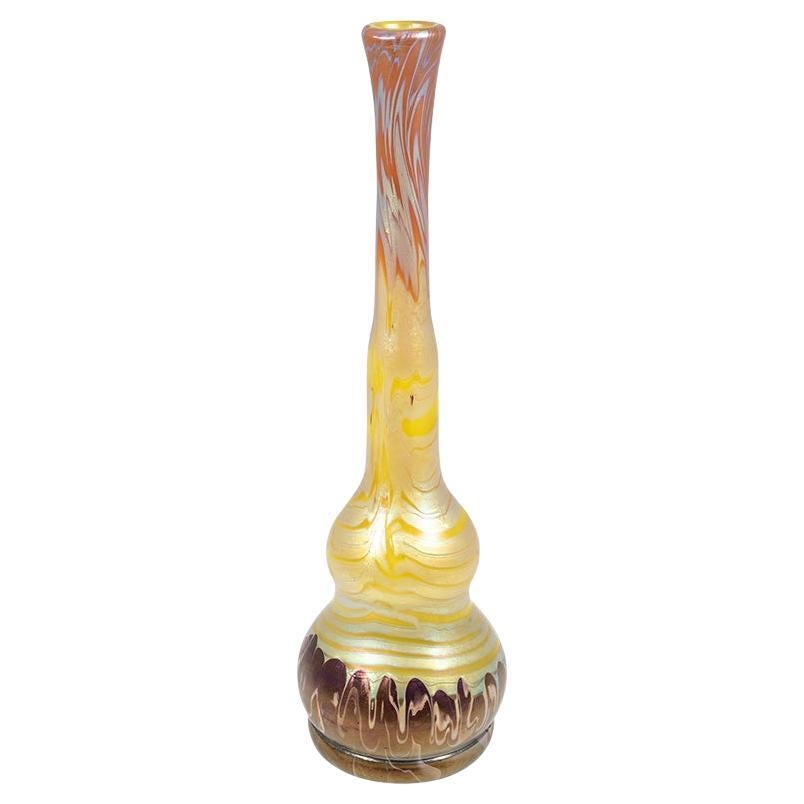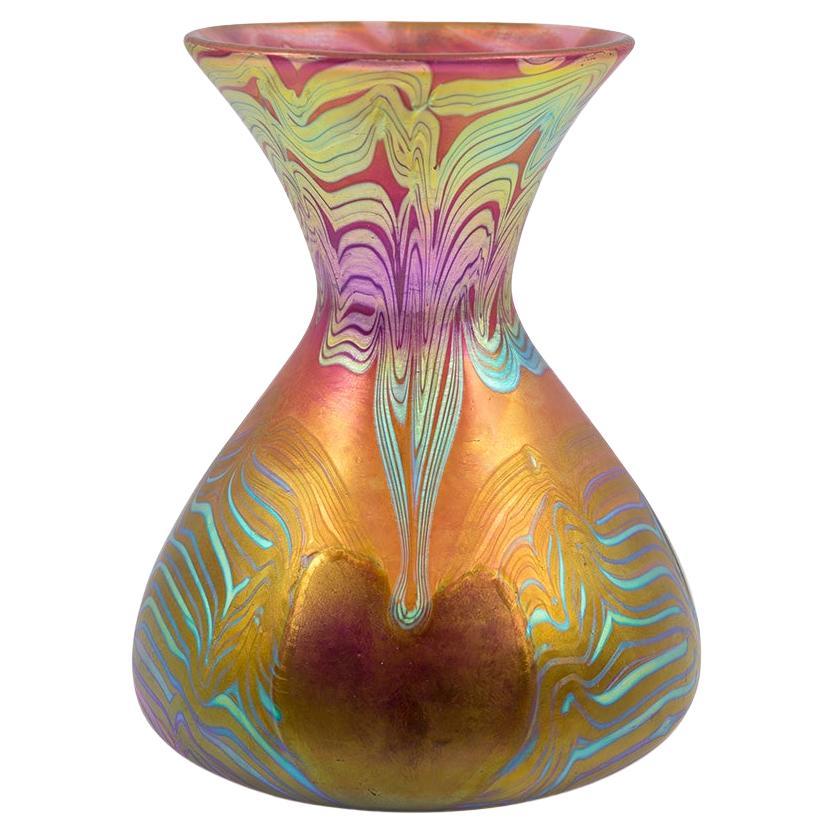Items Similar to Glass Vase Loetz PG Rubin 6893 Decoration circa 1900 Red Blue Art Nouveau
Want more images or videos?
Request additional images or videos from the seller
1 of 8
Glass Vase Loetz PG Rubin 6893 Decoration circa 1900 Red Blue Art Nouveau
About the Item
Glass vase, manufactured by Johann Loetz Witwe, Rubin 6893 decoration, PN 7468, ca. 1900, Art Nouveau, Jugendstil, Art Deco, art glass, iridescent glass, blue, red
Technique: Glass, mould-blown and freeform, reduced and iridescent
Bib.: E. Ploil, H. Ricke e.a. (ed.), „Loetz – Böhmisches Glas 1880-1940“, vol. II, Musterschnitte, Prestel, Munich 1989, paper pattern 674, p. 108
- Creator:Loetz Glass (Manufacturer)
- Dimensions:Height: 9.65 in (24.5 cm)Diameter: 3.75 in (9.5 cm)
- Style:Jugendstil (Of the Period)
- Materials and Techniques:
- Place of Origin:
- Period:
- Date of Manufacture:circa 1900
- Condition:Wear consistent with age and use.
- Seller Location:Klosterneuburg, AT
- Reference Number:
About the Seller
5.0
Vetted Seller
These experienced sellers undergo a comprehensive evaluation by our team of in-house experts.
Established in 2013
1stDibs seller since 2021
13 sales on 1stDibs
Typical response time: <1 hour
- ShippingRetrieving quote...Ships From: Klosterneuburg, Austria
- Return PolicyA return for this item may be initiated within 14 days of delivery.
More From This SellerView All
- Glass Vase Loetz PG 358 Decoration circa 1900 Art Nouveau Jugendstil BohemiaBy Loetz GlassLocated in Klosterneuburg, ATBohemian glass vase, manufactured by Johann Loetz Witwe, PG 358 decoration (world exhibition decoration), ca. 1900, orange, brown, ochre, silver, white, Bohemia, Viennese Art Nouveau...Category
Early 20th Century Austrian Jugendstil Glass
MaterialsGlass
- Bohemian Glass Vase Loetz PG 358 Decoration circa 1900 Art Nouveau SignedBy Loetz GlassLocated in Klosterneuburg, ATBohemian glass vase, manufactured by Johann Loetz Witwe, PG 358 decoration (world exhibition decoration), ca. 1900, signed, orange, brown, ochre, silver, white, Bohemia, Viennese Art...Category
Early 20th Century Austrian Jugendstil Glass
MaterialsGlass
- Bohemian Glass Vase Loetz PG 358 circa 1900 Art NouveauBy Loetz GlassLocated in Klosterneuburg, ATAustrian Jugendstil glass vase manufactured by Johann Loetz Witwe, Phenomen Genre 358 decoration, circa 1900 This glass vase is an extraordinary example of the Loetz manufactory its...Category
Early 20th Century Austrian Jugendstil Glass
MaterialsGlass
- Bohemian Glass Vase Loetz PG 358 circa 1900 Art NouveauBy Loetz GlassLocated in Klosterneuburg, ATAustrian Jugendstil glass vase manufactured by Johann Loetz Witwe, Phenomen Genre 358 decoration, circa 1901 This glass vase is an extraordinary example of the Loetz manufactory its...Category
Early 20th Century Austrian Jugendstil Glass
MaterialsGlass
- Glass Vase Loetz PG 3/492 Decoration circa 1903 Pink Green Blue Art NouveauBy Loetz GlassLocated in Klosterneuburg, ATGlass vase, manufactured by Johann Loetz Witwe, PG 3/492 decoration, production number II/963, ca. 1903, Bohemia, Art Nouveau, Jugendstil, Art Deco, art glass, iridescent glass, pink...Category
Early 20th Century Austrian Jugendstil Glass
MaterialsGlass
- Glass Vase Loetz PG 1/214 Decoration circa 1901 Orange Blue Silver Art NouveauBy Loetz GlassLocated in Klosterneuburg, ATGlass vase, manufactured by Johann Loetz Witwe, PG 1/214 decoration, ca. 1901, signed Art Nouveau, Jugendstil, Art Deco, art glass, iridescent glass, orange, blue, silver signed "Lo...Category
Early 20th Century Austrian Jugendstil Glass
MaterialsGlass
You May Also Like
- Loetz Art Nouveau Glass Vase Phenomenon Gre Crete 6893, Austria-Hungary, Ca 1900By Loetz GlassLocated in Vienna, ATFinest Bohemian Art Nouveau Glass Vase: Blown into form baluster-shaped body with discus-shaped protruding belly part, attached spherical curved neck with flared mouth rim, stepped f...Category
Antique Early 1900s Austrian Art Nouveau Glass
MaterialsGlass
- Loetz Vase Art Nouveau Secessionist Art Glass Phaenomen 6893 Antique LötzBy Loetz GlassLocated in Bad Säckingen, DEAntique Art Nouveau chalice shaped art glass vase created by the Loetz glassworks company, which was active during the late 19th and early 20th centuries, this vase represents a prime example of their artistic mastery. The vase features a cobalt blue ground that adds depth and richness to its overall appearance. Its surface showcases a captivating iridescent wave pattern, which adds a mesmerizing shimmer and dynamic quality to the glass. This iridescence is a hallmark of Loetz glassware and is achieved through the application of special techniques during the glassblowing process. The chalice-form of the vase gives it an elegant and graceful silhouette. This design creates a harmonious balance between the visually striking upper portion and the sturdy base. Loetz glasswares are renowned for their exceptional artistry and their ability to capture and play with light. The Phaenomen Genre 6893 vase, with its dark blue color and iridescent wave pattern, is no exception. When light interacts with the glass, it reveals a captivating range of colors and reflections, making it a visually stunning and attention-grabbing piece. As an antique Loetz glass vase...Category
Antique 1890s Austrian Art Nouveau Vases
MaterialsLuster, Glass, Art Glass, Blown Glass
- Rare and Important Loetz Phaenomen Vase Mountain Blue PG 6893 made 1898By Loetz GlassLocated in Worcester Park, GBA stunning and fully documented Loetz Phaenomen Vase. This example is documented Phaenomen pattern PG 6893 and the colouring is called Mountain blue (green over a blue ground) - The ...Category
Antique 1890s Czech Art Nouveau Glass
MaterialsArt Glass
- Loetz Art Nouveau Single Flower Vase, Phenomenon Gre Candia 6893, circa 1898By Loetz GlassLocated in Vienna, ATFinest Bohemian Art Nouveau glass vase: Mold-blown, disc-shaped body on a flush stand with raised, slender, trumpet-shaped, widening neck, flatened, 10-times wave-shaped mouth rim, ...Category
Antique 1890s Austrian Art Nouveau Glass
MaterialsGlass
- Rare and Important Loetz Phaenomen Vase Crete PG 6893 made 11898By Loetz GlassLocated in Worcester Park, GBA stunning and fully documented Loetz Phaenomen Vase. This example is documented Phaenomen pattern PG 6893 and the colouring is called Crete (green) - The pattern PG 6893 has thread...Category
Antique 1890s Czech Art Nouveau Glass
MaterialsArt Glass
- Vase Loetz , Style : Art Nouveau , Bohemia, circa 1900By Loetz GlassLocated in Ciudad Autónoma Buenos Aires, CLoetz The glass factory, originally founded in 1836 by Johann Baptist Eisner, was taken over. Loetz was the premier Bohemian glass works during this period. It was located in Klostermühle, near Rejštejn in the Sušice district in South-West Bohemia, which belonged to the Austro-Hungarian Empire until 1918. Susanna Loetz, widow of Glass entrepreneur Johann Loetz in 1852. She renamed the company "Glasfabrik Johann Loetz Witwe", a name that was retained until all activities were stopped in 1947. In 1879 it passed to Max Ritter von Spaun. Under his guidance, together with director Eduard Prochaska, the glassworks flourished as never before and enjoyed its most successful period. Von Spaun and Prochaska concentrated on the development of innovative glass types and new production techniques. Their first successful speciality was a glass type simulating semiprecious stones. It is often called "Marmoriertes Glas" ("marbled glass"). The range contained Onyx (red/brown), Karneol (red/pink) and later Malachit (green). It was introduced in the second half of the 1880's. From the same period dates the Octopus glass, of which the decor resembles the tentacles of a cephalopod. The production of Marmorier-tes Glas was resumed in 1906, in different colours like yellow and white. Octopus, 1885-1890, 1885-1890, unknown, an Malachit, 1885-1890, unknown, The master glass-blowers of Klostermühle had already carried out experiments with iridescence in the first half of the 1890's, and they produced the Olympia, a classically inspired olive green type, in 1896. Similar, in variants of creta green, bronce or Olympia and averse to any redundant decoration was the Glatt decor. It highly contrasted with the more elaborate finishes of that time, but it constitutes a part of the production with a deep sense for taste and quality. Most of the pieces shown in the "Glatt" decors were manufactured for Max Emmanuel in London. The glatt decor remained in use for many years. The Chiné decor had thin glass threads spun around the body in irregular patterns. It is not to be confused with the type of glass that was produced by Kralik. Loetz "Chiné" came in clear, opal, green and pink, Kralik "Chiné" in dark purple. The logical sequel to Chiné was the Pampas decor, green or cobalt blue, in which the threads almost disappeared in the surface, with iridised parts in between. Around the same time the dotted Papillon decor was introduced. The beautiful silver spots were employed on a wide array of models and quite effective on the gooseneck (water sprinkler) and sea shell...Category
Antique Early 1900s Austrian Art Nouveau Glass
MaterialsArt Glass





